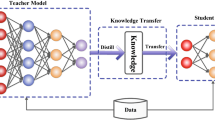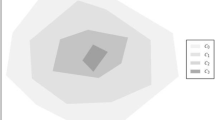Abstract
Open Set Domain Adaptation (OSDA) reduces domain shift and semantic shift by dividing the known/unknown target samples and aligning the known target samples with the source samples. Unfortunately, either separating or aligning first will cause the negative shift to the other side. Moreover, numerous methods do not utilize the sample knowledge of the target domain. In this study, a new method is put forward to address the issue called Sample Separation and Domain Alignment Complementary Learning Mechanism (CLM) for Open Set Domain Adaptation. Specifically, this work proposes a complementary learning mechanism that jointly trains two complementary learning structures including Sample Separation Module (SSMod) and Domain Alignment Module (DAMod). SSMod and DAMod are performed simultaneously, exchanging training experiences during the learning process using the self-supervised pseudo-labeling method. In addition, we introduce a novel sample separation method, which not only facilitates the distinction between known and unknown classes of target samples but also enriches the semantic knowledge of the model by employing the unlabeled data in an unsupervised manner. Extensive experiments demonstrate that our method realizes significant performance on four standard Digits, Office-31, Office-Home and VisDA-2017 benchmarks. For example, CML achieves 89.2% accuracy of HOS on Office-31 and increases by 1.8% than the second best method.








Similar content being viewed by others
Data Availability
The datasets used in this study are publicly available online.
References
Xu Y, Chen L, Duan L, Tsang IW, Luo J (2021) Open set domain adaptation with soft unknown-class rejection. IEEE Transactions on Neural Networks and Learning Systems
Shermin T, Lu G, Teng SW, Murshed M, Sohel F (2020) Adversarial network with multiple classifiers for open set domain adaptation. IEEE Transactions on Multimedia
Zhong L, Fang Z, Liu F, Yuan B, Zhang G, Lu J (2021) Bridging the theoretical bound and deep algorithms for open set domain adaptation. IEEE Transactions on Neural Networks and Learning Systems
Liu J, Jing M, Li J, Lu K, Shen HT (2021) Open set domain adaptation via joint alignment and category separation. IEEE Transactions on Neural Networks and Learning Systems
Fu J, Wu X, Zhang S, Yan J (2019) Improved open set domain adaptation with backpropagation. In: 2019 IEEE international conference on image processing (ICIP), IEEE pp 2506–2510
Jing M, Li J, Zhu L, Ding Z, Lu K, Yang Y (2021) Balanced open set domain adaptation via centroid alignment. In: Proceedings of the AAAI conference on artificial intelligence, vol 35, pp 8013–8020
Long M, Cao Y, Wang J, Jordan M (2015) Learning transferable features with deep adaptation networks. In: International conference on machine learning, PMLR pp 97–105
Wang J, Chen Y, Hao S, Feng W, Shen Z (2017) Balanced distribution adaptation for transfer learning. In: 2017 IEEE international conference on data mining (ICDM), IEEE pp 1129–1134
Goodfellow I, Pouget-Abadie J, Mirza M, Xu B, Warde-Farley D, Ozair S, Courville A, Bengio Y (2014) Generative adversarial nets. Advances in neural information processing systems, p 27
Ganin Y, Lempitsky V (2015) Unsupervised domain adaptation by backpropagation. In: International conference on machine learning, PMLR pp 1180–1189
Long M, Cao Z, Wang J, Jordan MI (2018) Conditional adversarial domain adaptation. Advances in neural information processing systems, p 31
Tzeng E, Hoffman J, Saenko K, Darrell T (2017) Adversarial discriminative domain adaptation. In: Proceedings of the IEEE Conference on computer vision and pattern recognition, pp 7167–7176
Loghmani MR, Vincze M, Tommasi T (2020) Positive-unlabeled learning for open set domain adaptation. Pattern Recogn Lett 136:198–204
Panareda Busto P, Gall J (2017) Open set domain adaptation. In: Proceedings of the IEEE International conference on computer vision, pp 754–763
Saito K, Yamamoto S, Ushiku Y, Harada T (2018) Open set domain adaptation by backpropagation. In: Proceedings of the European Conference on Computer Vision (ECCV), pp 153–168
Liu H, Cao Z, Long M, Wang J, Yang Q (2019) Separate to adapt: Open set domain adaptation via progressive separation. In: Proceedings of the IEEE/CVF conference on computer vision and pattern recognition, pp 2927–2936
Bucci S, Loghmani MR, Tommasi T (2020) On the effectiveness of image rotation for open set domain adaptation. In: European conference on computer vision, pp 422–438. Springer
Wang Q, Meng F, Breckon TP (2021) Progressively select and reject pseudo-labelled samples for open-set domain adaptation. arXiv:2110.12635
Gao Y, Chen P, Gao Y, Wang J, Pan Y, Ma AJ (2022) Hierarchical feature disentangling network for universal domain adaptation. Pattern Recogn 127:108616
Kirichenko P, Izmailov P, Wilson AG (2020) Why normalizing flows fail to detect out-of-distribution data. arXiv:2006.08545
Yan X, Zhang H, Xu X, Hu X, Heng P-A (2021) Learning semantic context from normal samples for unsupervised anomaly detection. In: Proceedings of the AAAI conference on artificial intelligence, vol 35, pp 3110–3118
Sun Y, Guo C, Li Y (2021) React: out-of-distribution detection with rectified activations. Advances in Neural Information Processing Systems, p 34
Zaeemzadeh A, Bisagno N, Sambugaro Z, Conci N, Rahnavard N, Shah M (2021) Out-of-distribution detection using union of 1-dimensional subspaces. In: Proceedings of the IEEE/CVF Conference on computer vision and pattern recognition, pp 9452–9461
Huang R, Geng A, Li Y (2021) On the importance of gradients for detecting distributional shifts in the wild. Advances in Neural Information Processing Systems, p 34
Liang S, Li Y, Srikant R (2017) Enhancing the reliability of out-of-distribution image detection in neural networks. arXiv:1706.02690
Liu W, Wang X, Owens J, Li Y (2020) Energy-based out-of-distribution detection. Adv Neural Inf Process Syst 33:21464–21475
Wang H, Liu W, Bocchieri A, Li Y (2021) Can multi-label classification networks know what they don’t know? Advances in Neural Information Processing Systems, p 34
Hartigan JA, Wong MA (1979) Algorithm as 136: a k-means clustering algorithm. J R Stat Soc Series C (applied statistics) 28(1):100–108
Lee D-h et al (2013) Pseudo-label: the simple and efficient semi-supervised learning method for deep neural networks. In: Workshop on challenges in representation learning, ICML, vol 3, p 896
LeCun Y, Bottou L, Bengio Y, Haffner P (1998) Gradient-based learning applied to document recognition. Proc IEEE 86(11):2278–2324
Netzer Y, Wang T, Coates A, Bissacco A, Wu B, Ng AY (2011) Reading digits in natural images with unsupervised feature learning
Hull JJ (1994) A database for handwritten text recognition research. IEEE Trans Pattern Anal Mach Intell 16(5):550–554
Saenko K, Kulis B, Fritz M, Darrell T (2010) Adapting visual category models to new domains. In: European conference on computer vision, pp 213–226. Springer
Venkateswara H, Eusebio J, Chakraborty S, Panchanathan S (2017) Deep hashing network for unsupervised domain adaptation. In: Proceedings of the IEEE conference on computer vision and pattern recognition, pp 5018–5027
Peng X, Usman B, Kaushik N, Hoffman J, Wang D, Saenko K (2017) Visda: The visual domain adaptation challenge. arXiv:1710.06924
You K, Long M, Cao Z, Wang J, Jordan MI (2019) Universal domain adaptation. In: Proceedings of the IEEE/CVF conference on computer vision and pattern recognition, pp 2720–2729
Jain LP, Scheirer WJ, Boult TE (2014) Multi-class open set recognition using probability of inclusion. In: European conference on computer vision, pp 393–409. Springer
He K, Zhang X, Ren S, Sun J (2016) Deep residual learning for image recognition. In: Proceedings of the IEEE conference on computer vision and pattern recognition, pp 770–778
Krizhevsky A, Sutskever I, Hinton GE (2012) Imagenet classification with deep convolutional neural networks. Adv Neural Inf Process Syst 25:1097–1105
Smith LN, Topin N (2019) Super-convergence: very fast training of neural networks using large learning rates. Artificial intelligence and machine learning for multi-domain operations applications, vol 11006, International Society for Optics and Photonics p 1100612
Lian Q, Li W, Chen L, Duan L (2019) Known-class aware self-ensemble for open set domain adaptation. arXiv:1905.01068
Fang Z, Lu J, Liu F, Xuan J, Zhang G (2020) Open set domain adaptation: Theoretical bound and algorithm. IEEE Trans Neural Netw Learn Syst 32(10):4309–4322
Gao Y, Ma AJ, Gao Y, Wang J, Pan Y (2020) Adversarial open set domain adaptation via progressive selection of transferable target samples. Neurocomputing 410:174–184
Kundu JN, Venkat N, Revanur A, Babu RV et al (2020) Towards inheritable models for open-set domain adaptation. In: Proceedings of the IEEE/CVF conference on computer vision and pattern recognition, pp 12376–12385
Mendes Júnior PR, De Souza RM, Werneck RdO, Stein BV, Pazinato DV, de Almeida WR, Penatti OA, Torres RdS, Rocha A (2017) Nearest neighbors distance ratio open-set classifier. Mach Learn 106(3):359–386
Pan SJ, Tsang IW, Kwok JT, Yang Q (2010) Domain adaptation via transfer component analysis. IEEE Trans Neural Netw 22(2):199–210
Long M, Wang J, Ding G, Sun J, Yu PS (2013) Transfer feature learning with joint distribution adaptation. In: Proceedings of the IEEE International conference on computer vision, pp 2200–2207
Zhang J, Li W, Ogunbona P (2017) Joint geometrical and statistical alignment for visual domain adaptation. In: Proceedings of the IEEE conference on computer vision and pattern recognition, pp 1859–1867
Acknowledgements
This work is supported by the National Key Research and Development Program of China (No. 2020YFA0714103), the Innovation Capacity Construction Project of Jilin Province Development and Reform Commission (2021FGWCXNLJSSZ10, 2019C053-3) and the Fundamental Research Funds for the Central Universities, JLU.
Author information
Authors and Affiliations
Corresponding author
Additional information
Publisher’s note
Springer Nature remains neutral with regard to jurisdictional claims in published maps and institutional affiliations.
Rights and permissions
Springer Nature or its licensor (e.g. a society or other partner) holds exclusive rights to this article under a publishing agreement with the author(s) or other rightsholder(s); author self-archiving of the accepted manuscript version of this article is solely governed by the terms of such publishing agreement and applicable law.
About this article
Cite this article
Sifan, L., Shengsheng, W., Xin, Z. et al. Sample separation and domain alignment complementary learning mechanism for open set domain adaptation. Appl Intell 53, 18790–18805 (2023). https://doi.org/10.1007/s10489-022-04262-0
Accepted:
Published:
Issue Date:
DOI: https://doi.org/10.1007/s10489-022-04262-0




